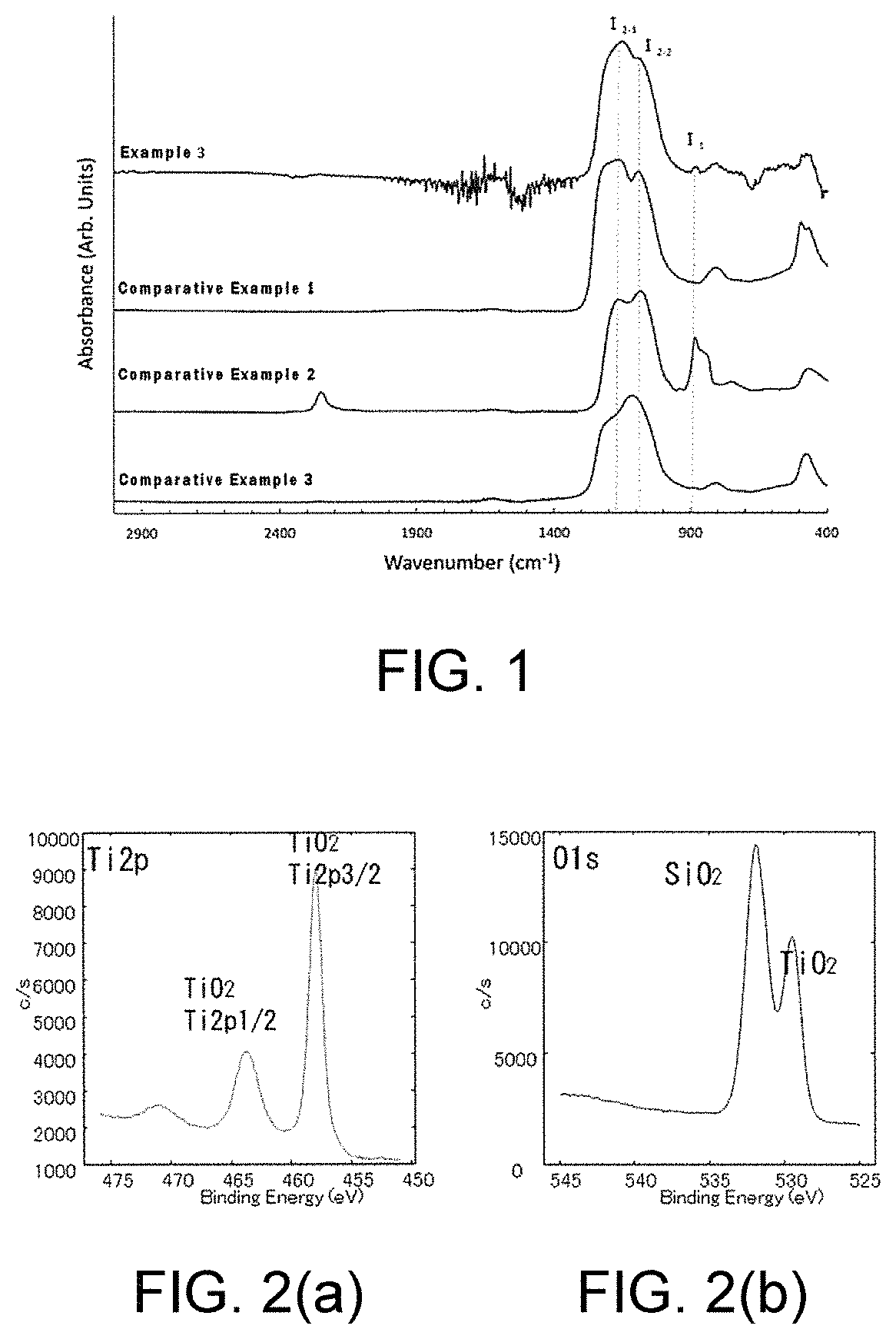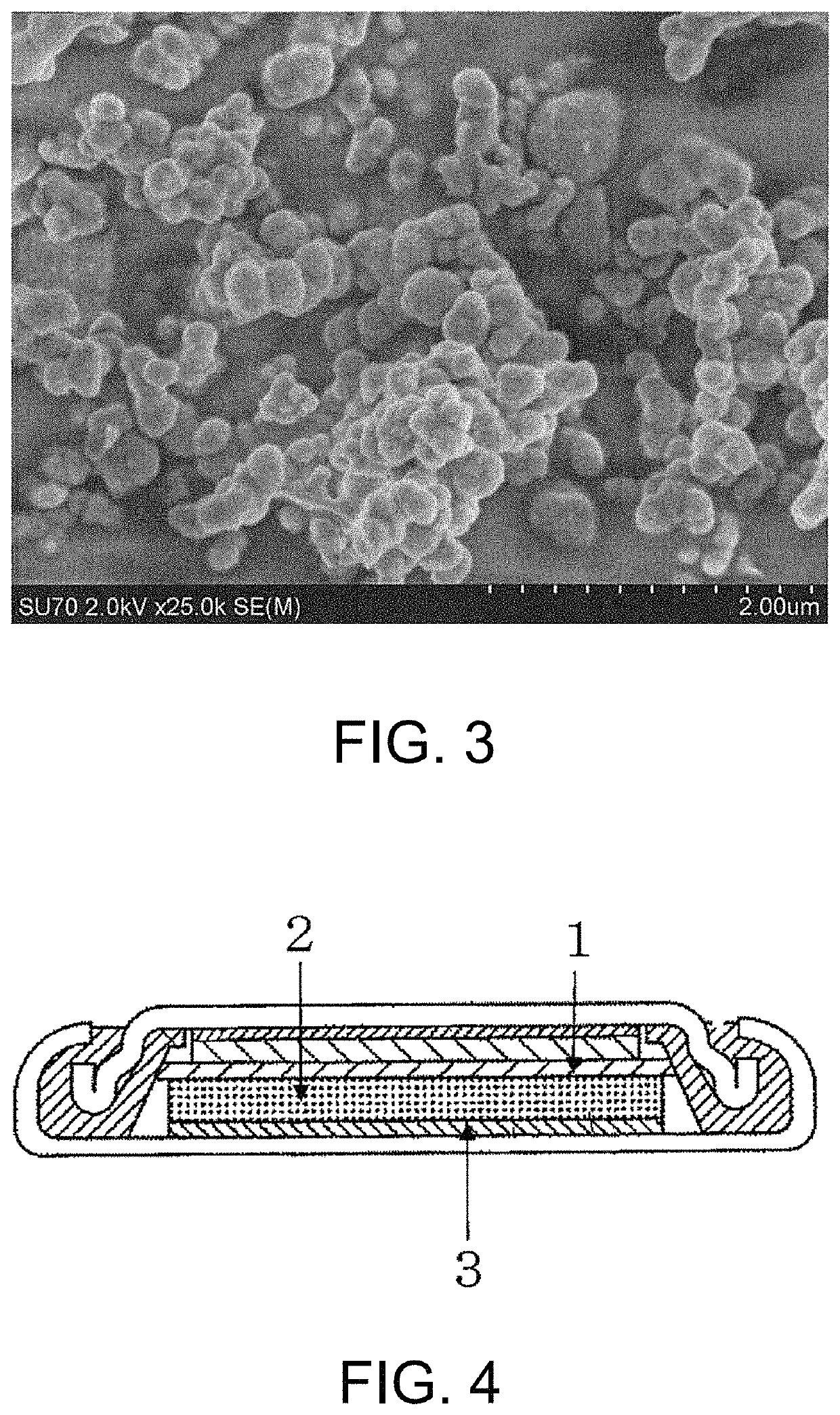Silicon nanoparticle-containing hydrogen polysilsesquioxane calcined product-metal oxide complex and production method thereof, negative electrode active material for lithium ion battery, negative electrode for the lithium ion battery and lithium ion battery
a technology of metal oxide complex and hydrogen polysilsesquioxane, which is applied in the direction of silicon oxides, cell components, electrochemical generators, etc., can solve the problems of low charge-discharge efficiency, high reactivity, and unstable lithium metal itself, and achieve excellent charge-discharge cycle properties, high capacity, and high speed charge-discharge properties
- Summary
- Abstract
- Description
- Claims
- Application Information
AI Technical Summary
Benefits of technology
Problems solved by technology
Method used
Image
Examples
example 1
(Preparation of Silicon Nanoparticle-Containing Hydrogen Polysilsesquioxane Powder (1))
[0140]In a 50 mL poly beaker, 20 g of pure water and 1.92 g of silicon nanopowder (Sigma-Aldrich Corp., less than 100 nm (volume-basis mean particle size; the size was more than 10 nm.)) were put to prepare aqueous silicon nanoparticle dispersion by using an ultrasonic cleaning bath. Into a 500 mL three-neck flask, the silicon nanoparticle dispersion, 2.43 g (24 mmol) of 36% by weight (concentration) hydrochloric acid and 218.6 g of pure water were added, the silicon nanoparticles were dispersed with stirring at room temperature for 10 minutes, and 45 g (274 mmol) of a triethoxysilane (Tokyo Chemical Industry Co., Ltd.) was added dropwise thereto at 25° C. under stirring. After completion of dropwise addition, the hydrolysis reaction and the condensation reaction were carried out at 25° C. for 2 hours while the mixture was stirred.
[0141]After elapse of the reaction time, reaction products were fil...
example 2
(Preparation of Silicon Nanoparticle-Containing Hydrogen Polysilsesquioxane Powder (2))
[0150]In a 500 mL poly beaker, 200 g of pure water and 19.2 g of a silicon nanopowder (Sigma-Aldrich Corp., less than 100 nm; volume-basis mean particle size, (The particle size was more than 10 nm.) were added to prepare a silicon nanoparticle dispersed aqueous solution by using an ultrasonic cleaning bath. Into a 3 L separable flask, the aqueous silicon nanoparticle dispersion, 12.2 g (120 mmol) of 36% by weight (concentration) hydrochloric acid, and 0.94 kg of pure water were charged, and the resulting mixture was stirred at room temperature for 10 minutes to wholly disperse silicon nanoparticles therein, and 167 g (1.37 mol) of a trimethoxysilane (Tokyo Chemical Industry Co., Ltd.) was added dropwise thereto at 25° C. under stirring. After completion of dropwise addition, the hydrolysis reaction and the condensation reaction were carried out at 25° C. for 2 hours while the mixture was stirred....
example 3
(Preparation of Silicon Nanoparticle-Containing Hydrogen Polysilsesquioxane Powder (3))
[0155]A silicon nanoparticle-containing hydrogen polysilsesquioxane powder (3) was obtained in the manner which is the same as Example 2 except that a charging amount of silicon nanopowder (Sigma-Aldrich Corp., less than 100 nm; volume-basis mean particle size, The particle size was more than 10 nm) was changed to 77.0 g in preparation of the silicon nanoparticle-containing hydrogen polysilsesquioxane.
(Preparation of Silicon Nanoparticle-Containing Hydrogen Polysilsesquioxane Calcined Product (3))
[0156]A Silicon nanoparticle-containing hydrogen polysilsesquioxane calcined product (3) was prepared by using the silicon nanoparticle-containing hydrogen polysilsesquioxane powder (3) in the manner which is the same as Example 1. The infrared spectroscopy spectrum of the silicon nanoparticle-containing hydrogen polysilsesquioxane calcined product (3) are shown in FIG. 1 (represented as Example 3 in FIG....
PUM
| Property | Measurement | Unit |
|---|---|---|
| volume-basis mean particle size | aaaaa | aaaaa |
| volume-basis mean particle size | aaaaa | aaaaa |
| temperature | aaaaa | aaaaa |
Abstract
Description
Claims
Application Information
 Login to View More
Login to View More - R&D
- Intellectual Property
- Life Sciences
- Materials
- Tech Scout
- Unparalleled Data Quality
- Higher Quality Content
- 60% Fewer Hallucinations
Browse by: Latest US Patents, China's latest patents, Technical Efficacy Thesaurus, Application Domain, Technology Topic, Popular Technical Reports.
© 2025 PatSnap. All rights reserved.Legal|Privacy policy|Modern Slavery Act Transparency Statement|Sitemap|About US| Contact US: help@patsnap.com


